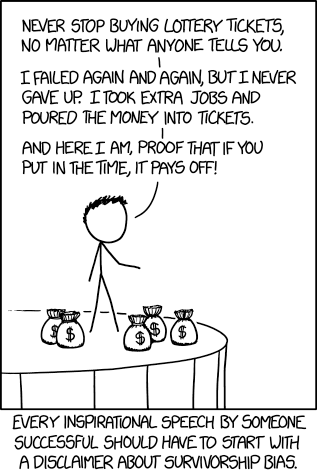Learn from other entrepreneurs’ mistakes, you don’t have enough time to make them all on your own.
Learn From Other Entrepreneurs’ Mistakes
 There is a tendency to think that starting your own business allows you to “break all of the rules.” I believe that a willingness to explore what-ifs and “play with possibilities” is very helpful, but a little goes a long way. Same for “breaking rules.” Break two or three intentionally, but the more you get outside the bounds of what has made other businesses successful, the more likely each addition mutation will prove painful, if not fatal. I read this account of a failed startup by C. J. Gustafson “I lost $209,640 of my own money trying to start a business” and I was disappointed.
There is a tendency to think that starting your own business allows you to “break all of the rules.” I believe that a willingness to explore what-ifs and “play with possibilities” is very helpful, but a little goes a long way. Same for “breaking rules.” Break two or three intentionally, but the more you get outside the bounds of what has made other businesses successful, the more likely each addition mutation will prove painful, if not fatal. I read this account of a failed startup by C. J. Gustafson “I lost $209,640 of my own money trying to start a business” and I was disappointed.
They followed their vision, but there was no small-scale experimentation. There were no MVP efforts and no real effort at customer discovery. The net result was that they spent $76K on outsourced development in the first year and generated no revenue.
A prudent entrepreneur would have revisited key assumptions and run some experiments. Instead, they spent another $30K on incremental development and netted $53 (please note $53, not $53K). They persisted another year, burned through another $24K, and netted $665 (again, no “K”).
It’s easy to criticize in hindsight, but I have to believe if they had compared notes with other entrepreneurs as they went, they would have started differently and course corrected much sooner and more frequently. All of their “lessons learned” are in other startup postmortems from the last 15 years: three weeks in the library might have saved them three years of wasted effort.
My takeaways from Gustafson’s story:
- Don’t hire an outsourced development team to implement your vision of an application as if you were commissioning an artist to realize your vision for a sculpture or a mural.
- Actually, don’t hire an outsourced development team until you have exhausted what you can accomplish with off-the-shelf and no-code tools to provide value to your customers. If you don’t have paying customers don’t hire an outsource team.
- If possible, offer it as a service (either concierge model or Wizard of Oz) and get five customers. Or charge for a result that a customer wants and dispense with putting any new software into prospects’ hands until you know five customers are willing to pay (something) for what you can deliver. I know this won’t work in all cases, but it will work in many cases if you proceed from a deep understanding of what the customer is paying for.
What are your reactions to the original entrepreneur’s approach? What questions would you have asked if you had met them at a Bootstrapper Breakfast before they started–or six months in–? What would you have suggested they consider?
Related Blog Posts
Common Mistakes
- Rob Fitzpatrick: Five Mistakes Bootstrappers Should Avoid in 2021
- Ten Mistakes Early Stage Bootstrappers Often Make
- Five Serious Financial Mistakes Bootstrappers Can Avoid
- Howard Tullman on Distinguishing Mistakes From Failure
- Common Mistakes in New Product Introduction Demos
- 5 Mistakes CEOs Make In Demos
Lessons Learned
- Learning From Netflix’s 2011 Pricing Strategy Mistakes
- Learning From Netflix: Lenny Greenberg’s Response
- Newsletter Q2/2024: Surprise is a marker for learning
- Moe Arnaiz: Lessons Learned Bootstrapping eMOBUS and Weeldi
- Michal Mazurek on Lessons Learned Bootstrapping Syften
- Alastair Hood: Lessons Learned Bootstrapping Verdafero
- Arun Kumar: 9 Lessons Learned Bootstrapping Kerika
- Hiten Shah: Four Lessons I Learned Squandering My Opportunity at KISSMetrics
- B.V. Jagdeesh on “Startup Leadership Lessons Learned”
- Learning the Right Lessons From Failure
Image Credit: Survivorship Bias by Randall Munroe (XKCD); used with attribution.
